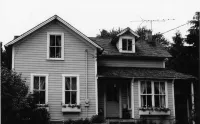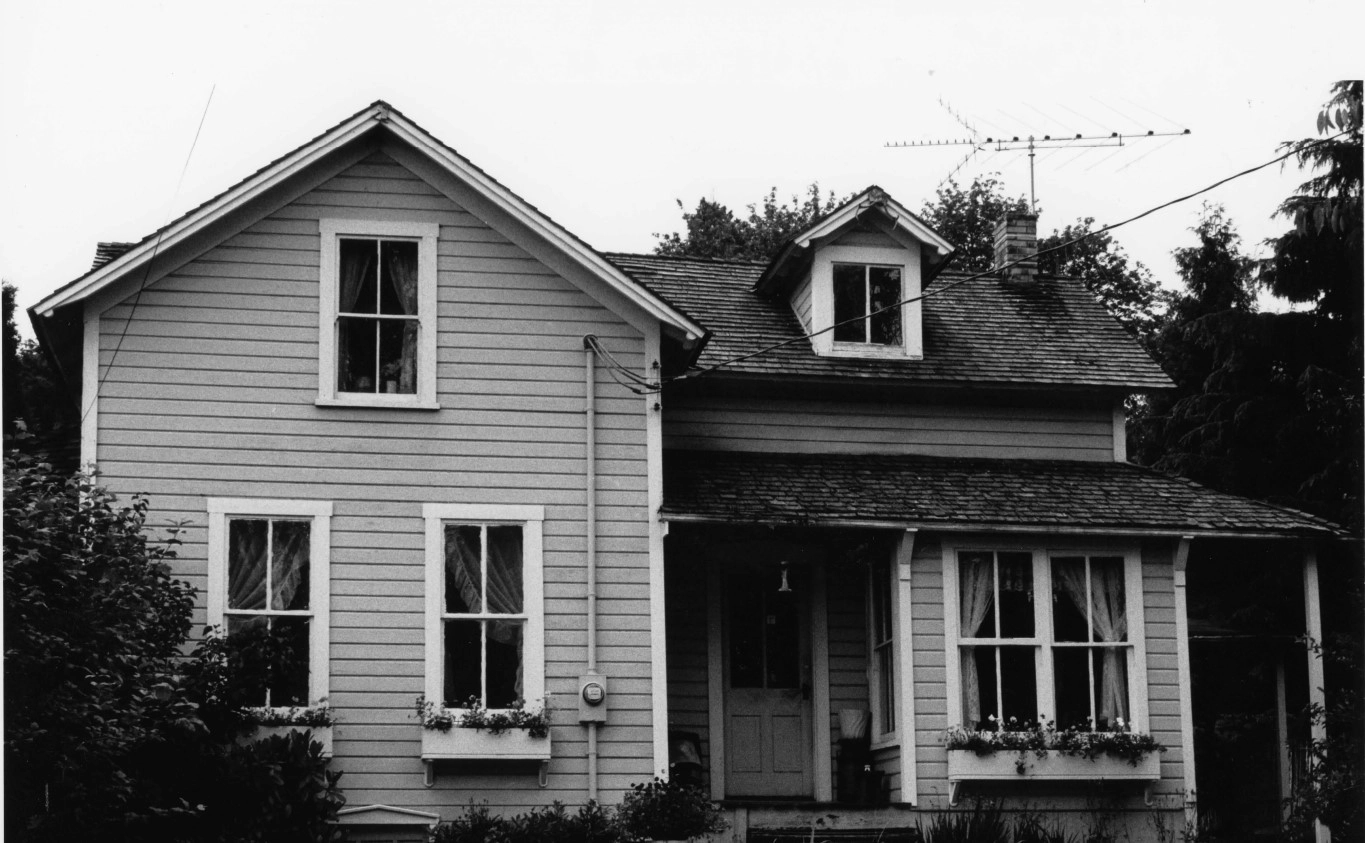Share what you know,
and discover more.
Share what you know,
and discover more.
Aug 27, 1990

-

- Charmaine Bantugan
National Register of Historic Places - Dr. Reuben Chase House
Statement of Significant: Built about 1885, the Dr. Reuben Chase house is historically significant for its association with Bothell's first doctor and as an example of pioneer era residential architecture in the city. The house, which is characterized by its simple gable-and-wing form, was the site of the doctor's office and the community's first hospital, established at a time when the area was suffering from a typhoid epidemic. The house is located in String town, the area's first residential neighborhood on the north bank of the Sammamish River and is the best preserved of the houses built in that district. Today, the Chase house is among a handful of significant structures associated with the city's formative years of the 1880s. Historical Background: Dr. Reuben Chase was a native of Rutland, Vermont, who, after service in the Civil War, studied medicine in Cincinnati, where he earned his medical degree from the Eclectic Medical College in 1877. In 1889, Chase migrated west to the Pacific Northwest searching for a favorable climate in order to relieve recurrent attacks of malaria. Upon his arrival in Seattle that year, the state medical association directed Chase to the small community of Bothell which at the time was without a physician and in the midst of a typhoid epidemic that had totaled 40 cases. In the Bothell area, Chase set up practice in a frame house probably built a few years earlier in the community's first residential area known as String town. The house served both as office, the community's first hospital, and Chase's residence. During his tenancy he expanded the building slightly by adding several bay windows, including a box bay beneath the front porch. Chase was successful in fighting the typhoid epidemic; reputedly, he saved all but one of his patients. In addition to serving as the town doctor, Chase contracted to cut wood to heat the schoolhouse. Chased lived in the house until 1895, when he moved to Edmonds. In 1905, he moved to Snoqualmie to open another practice and died there in 1908. He is buried in the Bothell cemetery. The Chase house was built about 1885 and is a good example of the pioneer gable-and-wing form common to the period. Like others of the type, the Chase house is characterized by horizontal siding with simple corner and cornice trim, double- hung windows, and a T plan. At some point in the late 19th century, the porch was partially enclosed for a bay window, and a second bay was added to the side elevation. These changes to the house are consistent with the traditional character of the building, and reflect common alterations to houses at the turn of the century. A cultural resource survey identified the house as the best preserved of the three extant houses in string town and among the earliest and best-preserved frame houses in the city.
National Register of Historic Places - Dr. Reuben Chase House
Statement of Significant: Built about 1885, the Dr. Reuben Chase house is historically significant for its association with Bothell's first doctor and as an example of pioneer era residential architecture in the city. The house, which is characterized by its simple gable-and-wing form, was the site of the doctor's office and the community's first hospital, established at a time when the area was suffering from a typhoid epidemic. The house is located in String town, the area's first residential neighborhood on the north bank of the Sammamish River and is the best preserved of the houses built in that district. Today, the Chase house is among a handful of significant structures associated with the city's formative years of the 1880s. Historical Background: Dr. Reuben Chase was a native of Rutland, Vermont, who, after service in the Civil War, studied medicine in Cincinnati, where he earned his medical degree from the Eclectic Medical College in 1877. In 1889, Chase migrated west to the Pacific Northwest searching for a favorable climate in order to relieve recurrent attacks of malaria. Upon his arrival in Seattle that year, the state medical association directed Chase to the small community of Bothell which at the time was without a physician and in the midst of a typhoid epidemic that had totaled 40 cases. In the Bothell area, Chase set up practice in a frame house probably built a few years earlier in the community's first residential area known as String town. The house served both as office, the community's first hospital, and Chase's residence. During his tenancy he expanded the building slightly by adding several bay windows, including a box bay beneath the front porch. Chase was successful in fighting the typhoid epidemic; reputedly, he saved all but one of his patients. In addition to serving as the town doctor, Chase contracted to cut wood to heat the schoolhouse. Chased lived in the house until 1895, when he moved to Edmonds. In 1905, he moved to Snoqualmie to open another practice and died there in 1908. He is buried in the Bothell cemetery. The Chase house was built about 1885 and is a good example of the pioneer gable-and-wing form common to the period. Like others of the type, the Chase house is characterized by horizontal siding with simple corner and cornice trim, double- hung windows, and a T plan. At some point in the late 19th century, the porch was partially enclosed for a bay window, and a second bay was added to the side elevation. These changes to the house are consistent with the traditional character of the building, and reflect common alterations to houses at the turn of the century. A cultural resource survey identified the house as the best preserved of the three extant houses in string town and among the earliest and best-preserved frame houses in the city.
Aug 27, 1990
National Register of Historic Places - Dr. Reuben Chase House
Statement of Significant:Built about 1885, the Dr. Reuben Chase house is historically significant for its association with Bothell's first doctor and as an example of pioneer era residential architecture in the city. The house, which is characterized by its simple gable-and-wing form, was the site of the doctor's office and the community's first hospital, established at a time when the area was suffering from a typhoid epidemic. The house is located in String town, the area's first residential neighborhood on the north bank of the Sammamish River and is the best preserved of the houses built in that district. Today, the Chase house is among a handful of significant structures associated with the city's formative years of the 1880s.
Historical Background: Dr. Reuben Chase was a native of Rutland, Vermont, who, after service in the Civil War, studied medicine in Cincinnati, where he earned his medical degree from the Eclectic Medical College in 1877. In 1889, Chase migrated west to the Pacific Northwest searching for a favorable climate in order to relieve recurrent attacks of malaria. Upon his arrival in Seattle that year, the state medical association directed Chase to the small community of Bothell which at the time was without a physician and in the midst of a typhoid epidemic that had totaled 40 cases. In the Bothell area, Chase set up practice in a frame house probably built a few years earlier in the community's first residential area known as String town. The house served both as office, the community's first hospital, and Chase's residence. During his tenancy he expanded the building slightly by adding several bay windows, including a box bay beneath the front porch. Chase was successful in fighting the typhoid epidemic; reputedly, he saved all but one of his patients. In addition to serving as the town doctor, Chase contracted to cut wood to heat the schoolhouse. Chased lived in the house until 1895, when he moved to Edmonds. In 1905, he moved to Snoqualmie to open another practice and died there in 1908. He is buried in the Bothell cemetery.
The Chase house was built about 1885 and is a good example of the pioneer gable-and-wing form common to the period. Like others of the type, the Chase house is characterized by horizontal siding with simple corner and cornice trim, double- hung windows, and a T plan. At some point in the late 19th century, the porch was partially enclosed for a bay window, and a second bay was added to the side elevation. These changes to the house are consistent with the traditional character of the building, and reflect common alterations to houses at the turn of the century. A cultural resource survey identified the house as the best preserved of the three extant houses in string town and among the earliest and best-preserved frame houses in the city.
Posted Date
Jul 17, 2023
Historical Record Date
Aug 27, 1990
Source Name
National Register of Historic Places
Source Website
Delete Story
Are you sure you want to delete this story?








